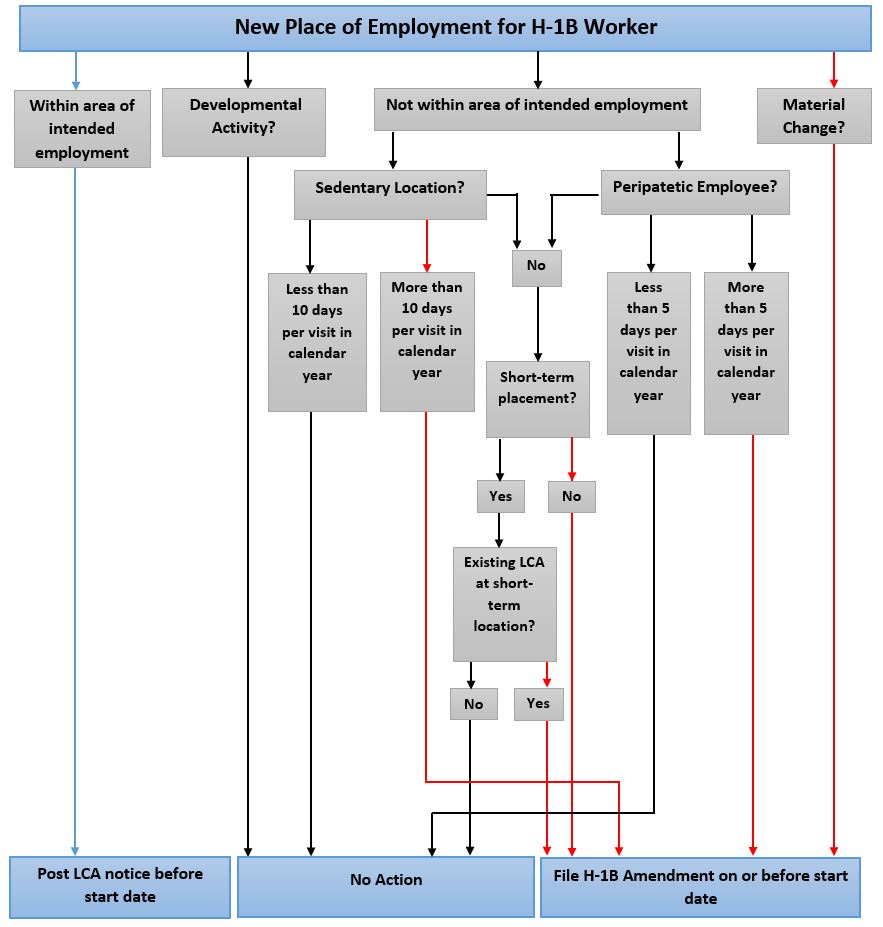WHEN YOUR H-1B EMPLOYEE CHANGES WORK LOCATION
Certain changes in work locations may require filing an H-1B amended petition, OR only posting the LCA notice at new location, OR no action. See flowchart below.
This fact sheet provides general information concerning short-term placement of H-1B workers outside the area of intended employment.
An area of intended employment[1] means an area within reasonable commuting distance (from home to work), usually a MSA (Metropolitan Statistical Area) or a CMSA (Consolidated Metropolitan Statistical Area). For example, if the new location is in the same zip code as the old location, the new location is within the same MSA as the old location.
In general, if the new job location is outside of the original area of intended employment, the H-1B employer must file an amended H-1B petition on or before the first day the H-1B employee begins work at the new job location.[2] Under certain circumstances, the H-1B employer may consider short-term placement of an H-1B worker. However, this option is only available if the employer has not filed an LCA for the same occupational classification in the short-term location.[3]
H-1B SHORT-TERM PLACEMENT
An H-1B employer may place an H-1B employee at a new worksite for up to 30 days in a one-year period without the need to file an amended H-1B or new H-1B petition as long as there are no material changes in the terms and conditions of employment and the following conditions are met:
- The H-1B employer does not place the H-1B employee at any worksite where there is a strike or lockout; AND
- The H-1B employer does comply with existing LCAs for all the worksites covered; AND
- For each day the H-1B employee is at the location outside the area of intended employment, the H-1B employer must pay:
- The higher of the prevailing or actual wage at the worksite; and
- The actual cost of lodging for both work and non-work days; and
- Reimburse the H-1B employee for the actual cost of travel, lodging, meals and incidental expenses for both work and non-work days.[4]
The 30 days can be extended up to a maximum of 60 days in a one-year period if:
- the H-1B employer can demonstrate that the H-1B employee maintains an office or workstation at the permanent job location with the H-1B employer, AND
- the H-1B employee spends a substantial amount of time at the permanent job location in a one year period, AND
- the H-1B employee has a U.S. residence located in the area of the permanent job location.[5]
At the end of the 30 or 60 day period, the employer must either transfer the employee back to the permanent worksite or file an amended H-1B for the new location.[6]
If any worker exceeds the workday limits within the one-year period, and no amended H-1B petition is filed, the employer has violated the terms of the LCA and cannot use short-term placement again for the same occupational classification within that geographic area.
This option cannot be used to continuously rotate workers into the area in order to avoid filing an LCA or providing notice at the new site.[7]
OTHER EXCEPTIONS
Assuming no material change, an H-1B amended petition is not required for the following 3 scenarios:
- Developmental Activities:[8] H-1B workers may attend conferences, seminars, retreats, training meetings, and other developmental events to fulfill the requirements of a particular job function without filing a new LCA. Note that this exception does not cover workers who are regularly engaged in providing the training or otherwise working at conferences or events.
- Peripatetic Employee:[9] The employee may not spend more than 5 consecutive workdays on any single visit. Some examples of peripatetic jobs include Physical Therapist, Speech Language Pathologist, Instructor/Tutor, and Auditor.
- Sedentary Location: This is the exception for the occasional traveler. Workers who spend most of their time at one worksite, which would be covered by a certified LCA, may also travel to another location without filing a new LCA if the visit is on a casual, short-term basis, and no single visit exceeds ten (10) consecutive workdays.

[1] 20 CFR § 655.715
[2] Matter of Simeio Solutions, LLC26 I&N Dec. 542 (AAO 2015)
[3] 20 CFR § 655.735
[4] 20 CFR § 655.735(b)(3)
[5] 20 CFR § 655.735(c)
[6] 20 CFR § 655.735(f)
[7] 20 CFR § 655.735(e)
[8] Fact Sheet #62J: What does “place of employment” mean?
[9] 20 CFR § 655.715
Also see 20 CFR Sec. 655 subparts H & I
- Immigration and Nationality Act Sec 212(n)
- DOL Fact Sheet #62K: What is the short-term placement option?
- 65 FR 80222, Dec. 20, 2000, as amended at 73 FR 19949, Apr. 11, 2008
- USCIS July 21, 2015 Policy Memorandum, PM-602-0120

